I Will Remember - Je Me souviendrai
HMCS ALBERNI - K103

When Canada declared war the day following the declaration of war by Great Britain, the country was thrown into action to build a new navy. Prior to that time, the RCN consisted of only 13 ships: six destroyers, five minesweepers and two training vessels. Added to this was a strength of 1,819 plus three naval reserve bodies together producing about 1,800 more men. Once these numbers began to swell however, the tailors couldn't keep up. It wasn't unusual for new recruits to have no uniform to wear into combat.
Using the plans from the British corvettes and combining them with blueprints for small whaling vessels, the corvettes that Canada began to produce evolved into newer versions almost monthly. The ALBERNI was refitted once during her lifetime when the mast was moved to behind the wheel house, but before she could be retrofitted with a longer foc'sle (pronounced: folksul ie: “fore castle”), she met her fate.
On July 26, 1944 she shot down a German Junkers 88 that had attacked her at almost sea level. ALBERNI opened fire with her starboard Oerlikons and the after pom-pom as the plane tore toward her. The Junkers climbed and banked to clear ALBERNI and her port Oerlikons scored direct hits at close range. The enemy burst into flames and exploded in the sea 1000 yards off ALBERNI'S port bow with no survivors. On 28 July she narrowly missed an aircraft-laid mine, then a depth charge laid over an asdic contact set off another mine 200 yards off ALBERNI'S starboard beam without significant damage. It was an exciting time.
Her CO, A/LCDr Ian H. Bell, RCNVR, the 26 year old commander, leaped out of his cabin at the explosion, planning to dash to the bridge. He was washed over the side as the ship foundered rapidly by the stern, with no time for orders or damage control. There was not even time to release Carley floats, and men, many without time to put on life belts as the ship foundered had to cling to odd pieces of debris. Fortunately the depth charges did not explode, although there was a muffled boiler explosion which did not seem to cause much harm. One seaman credited the new-style RCN life jackets, with protective crotch sections buckled to the upper jacket, with preventing groin injuries. One rating in boots and trousers, struggling in the sea, cast off his boots and then pushed down his trousers to be able to swim more easily. He suddenly recalled that his dentures were in the trouser pockets, so pulled them back up again. As an intelligence officer commented later after questioning the survivors, " He seemed to have all his teeth when I spoke to him"
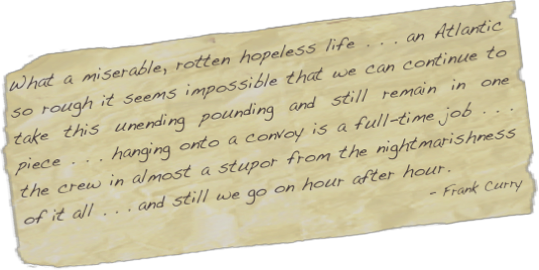
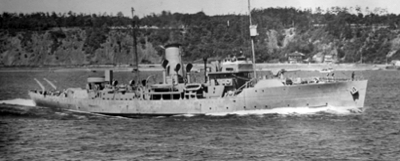
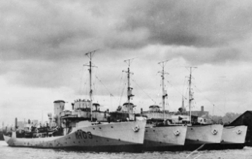
The ALBERNI was one of the Flower Class types after the British tradition of naming the ships after flowers. The Canadian ships were named after communities in Canada. The ALBERNI was named for Alberni. BC which is now known as Port Alberni on Vancouver Island (and thus after Captain Don Pedro Alberni who commanded the Spanish Soldiers sent to occupy Nootka in 1790). She was one of the first Corvettes to go into action.
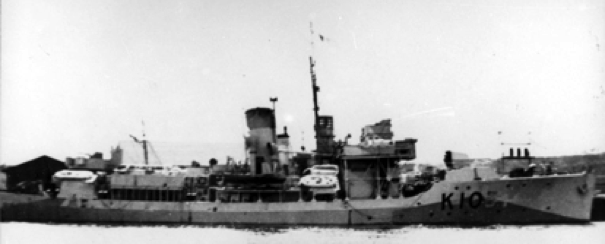
Built at the Yarrows Ltd. shipyard in Esquimalt, British Columbia, she was commissioned on February 4, 1941 and arrived at Halifax on April 13 in company with HMCS AGASSIZ. On May 23, 1941, the two ships departed for St. John's to join the recently formed Newfoundland Escort Force. ALBERNI left the following month with a convoy for Iceland, and served as a mid-ocean escort until May 1942 when she was taken out of service to have a new boiler installed. in September 1942, she had taken part in the defence of Convoy SC.42, which lost 18 ships to as many U-boats, fifteen merchantmen were sunk and U-501 was destroyed by CHAMBLY and MOOSE JAW.
Assigned to duties in connection with the invasion of North Africa, she sailed for the U.K. in October with Convoy HX.212, and until February 1942, escorted convoys between the U.K. and the Mediterranean. She returned to Halifax in March 1943 and served briefly with WEEF before transferring to Quebec Force in May. For the next five months she escorted Quebec-Labrador convoys, leaving Gaspe on November 6 to undergo repairs at Liverpool, N.S. With repairs completed early in February, she proceeded to Bermuda to work up, and on her return to Halifax joined EG W-4. On April 24 she sailed for the U.K. for duties connected with the coming invasion. ALBERNI was then based on Londonderry, and made a name for herself during 1942 by rescuing over 145 torpedoed merchant seamen on two occasions. She was assigned to escorting convoys in support of North African landings between Britain, Gibraltar and North African Ports. She was present with the Mediterranean convoys when VILLE DE QUEBEC and REGINA obtained their submarine kills but, as with U 501, did not have the chance for direct participation and credit. Reports did give ALBERNI a " Probably damaged" verdict after an attack in 1941. Returning to Canada in March 1943, she served in the Western Local and in the Gulf Escort Force in the St. Lawrence. Time was taken for a modest and partial refit. In April 1944 she was one of seventeen RCN corvettes sent to the UK in support of Operation Neptune, the landings at Normandy. In June and July she escorted a miscellaneous collection of landing craft and ships, barges, tugs and floating piers for Mulberry and merchant ships between Southampton Water and the Beaches.
On July 28, 1944 Corvette HMCS Alberni narrowly missed an aircraft-laid mine when a depth charge laid over an asdic contact set off another mine 200 yards off Alberni's starboard beam without significant damage.
"ALBERNI OERLIKONS"
artist : Marc MaGee, CSMA
acryllic
2013
HAMM main gallery
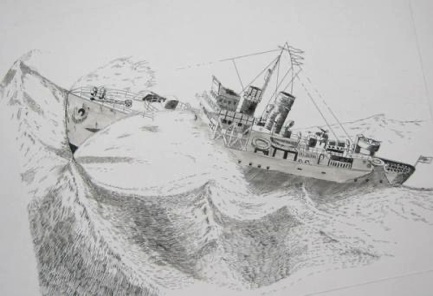
After brief maintenance at Southampton, ALBERNI was ordered to relieve HMCS DRUMHELLER on patrol for u-boats to the eastward of the swept channel leading to the Normandy beaches. At 1137 on August 21 she was steaming south at fourteen knots in fair weather with a NNE wind of five knots but State Four seas for the rendezvous, sweeping by asdic eighty-degrees on either bow, radar operating. "Hands to Dinner" had just been piped. Four minutes later, with no asdic warning whatsoever, she was hit by an accoustic torpedo fired from U-480 on her port side just aft of the engine room. Alberni was sunk by U-480 OLtzS Hans-Joachim Förster CO, at 1141, 25 miles SE of St. Catherine's Point, Isle of Wight, 50-18N 00-51W. In less than 10 seconds she was awash from the funnel aft, listing to port and sinking fast. In another twenty seconds she was gone, sinking stern first. Most of the off-watch hands were trapped in their mess decks, and only one stoker escaped from the engine and boiler rooms.
"HMCS ALBERNI UNDER WAY"
artist : Victor Prodnuk
pencil - date unknown
used with permission: Victor Prodnuk Estate
A/Lt. Frank Williams, a former football player and strong swimmer, was credited with saving several lives including those of Donald Wood, the ship's writer, and Ian Bell who was dazed by the suddenness of his ship's destruction. Williams was later, in January 1945, awarded the Royal Humane Society's bronze medal for saving life at sea for his efforts on this day.
For forty-five minutes the dazed survivors struggled to keep from drowning or giving up in heavy seas. Providentially HM motor Torpedo boats 469 and 470, returning from duties off Normandy and having seen an explosion and the startling disappearance of the corvette on their horizon, altered course to investigate. They came across the survivors and rescued three officers and twenty-eight men of the ship's company of ninety. They were taken to Portsmouth, where two moderately injured were admitted to hospital.
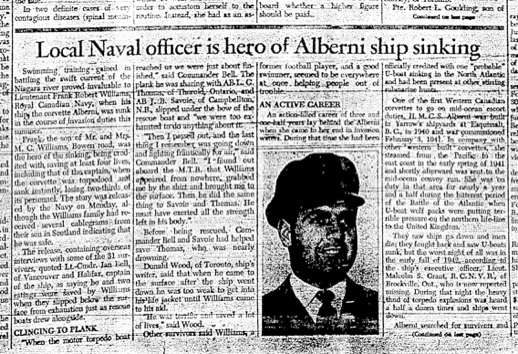
The "I WILL REMEMBER" and "JE ME SOUVIENDRAI" POPPY LOGO IS A TRADEMARK of the Alberni Project Society. Use of either English or French logo is prohibited without expressed written permission from the Alberni Project Society
Web services donated by Full Circle Media - Courtenay, BC 2018-2024